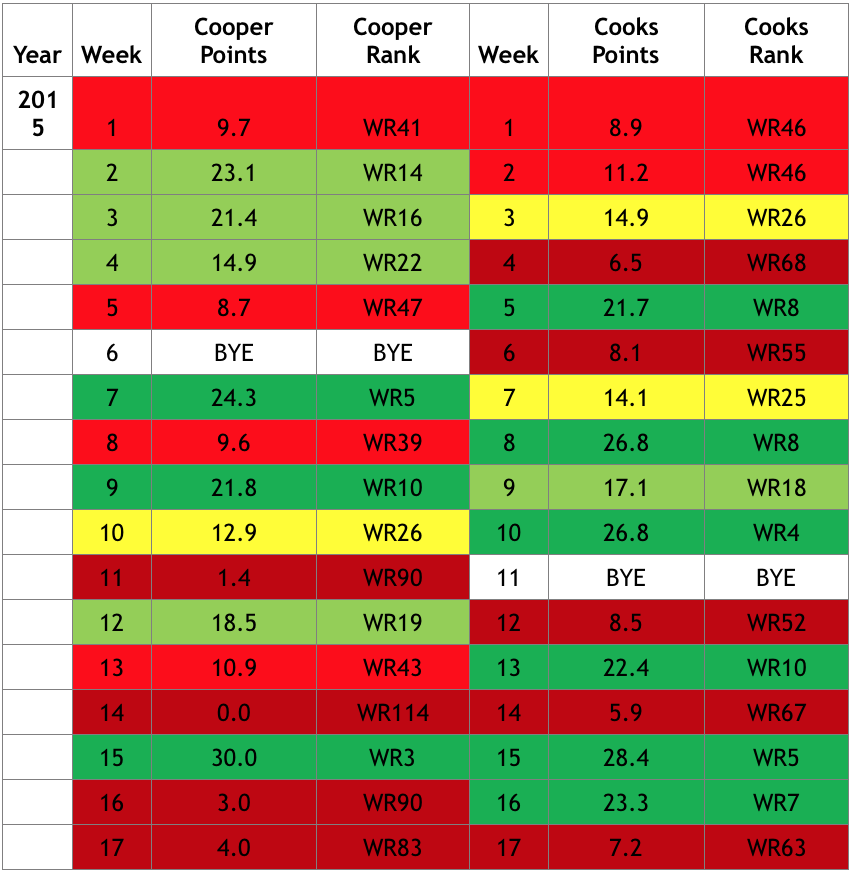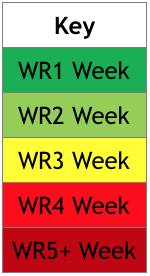Dynasty Purgatory: Amari Cooper and Brandin Cooks
We’ve all seen the meme where a man enters a nearly empty bathroom, complete with about ten urinals. He walks all the way down to the end, positions himself next to the only other occupant, and whispers…
Well, here’s where it changes depending on the topic of the day. Usually it’s something innocuous, poking fun at those who just love to talk about their seemingly-hipstery-but-actually-fairly-mainstream hobbies and lifestyle choices.
“Hey, I do crossfit.”
“Hey, I’m a vegan.”
You get the idea.
Though I’m sitting here on my couch typing these words, as opposed to walking the unsanitary grounds of your standard public restroom, let’s live out this meme from a fantasy football perspective:
<WALKING, ACQUIRING TARGET>
Whispers…
“If we used the data from the past couple of years instead of simply assuming guaranteed improvement, we could’ve avoided the fantasy minefields that are Amari Cooper and Brandin Cooks.”
Okay okay, put the pitchforks down for a second. I am not saying that Cooper and Cooks are bad players, because that would be highly disingenuous. I just don’t think they’re worth their respective costs, that’s all. And this is the Dynasty Purgatory series, where I take aim at those who seem to be at a bit of a crossroads – to me, this duo fits the bill.
[am4show have=’g1;’ guest_error=’sub_message’ user_error=’sub_message’ ]
According to the as-of-yet unreleased October DLF ADP, Cooper is checking in with a value of 6.8. Cooks is right behind him, at 18.3. Unfortunately, in my estimation, owners aren’t seeing the returns to justify the investment.
Now you might be thinking to yourself, that’s crazy. Sure, Cooper has started off slowly, but Cooks is the PPR WR12! And I’d agree with you, but…
(As we know Ned Stark said everything before the word “but” is horse droppings)
…but fantasy football is a weekly endeavor, not a system that is based on year-end, aggregate points (MFL10s aside). Cooks blew up in week three, of 2017, but has been a ghost otherwise. Herein lies the crux of my argument, one which has also been previously highlighted in the Searching for Consistent Greatness series by our own James Simpson.
Cooper and Cooks have seen some fantasy successes, sure. Cooper was the PPR WR21 in 2015 as a rookie, and the WR16 last season. As a second-year player, Cooks was the PPR WR14 in 2015, and followed that up last season as the WR11. But I’m more concerned the paths they took, not the endpoints.
To that point, please consider the below table, which lists each player’s weekly output and PPR fantasy finishes dating back to 2015 and continuing through the first four games of the 2017 season (color key shown below):




As you can see in the above, there are enough colors to create a pretty diverse bag of Skittles. Let’s sum them all up, and attempt to make sense of it all. Consider the table below, which shows the number of instances of each type of weekly performance (out of a total of 36 games):

Continuing, let’s break these finishes down by the percentage of each instance:

Are the above numbers inherently awful? Not by a longshot, but again, the output always needs to compared to the cost. If you’re paying elite prices, you should be expecting elite output, and neither Cooper nor Cooks are delivering it on a weekly basis.
Cooper is only functioning as a weekly WR1 wrecking ball 22.22% of the time, with Cooks coming in a bit higher at 27.78%. Each is supplementing that with achieving a WR2 finish at 16.67% of the time. On the aggregate, Cooper is a weekly WR2 or better an underwhelming 38.89% of the time, with Cooks reaching the same benchmark at a rate of 44.45%.
On the other end of the spectrum, Cooper has been a WR4 or worse at a 52.78% clip, with Cooks a bit better at 36.12%. Notably though, both players are a WR5 or worse (49th best receiver or worse) more often than they are a WR1. Cooks, at the minimum, has found the WR3 middle ground nearly one-fifth of the time, while Cooper has proven to be a distinctive boom-or-bust prospect. All of the above is reflected in their weekly average finishes of 41.4 for Cooper, and 35.4 for Cooks. Yikes.
Digging a little bit deeper, I think it’s important to glean where exactly each player typically fits into the above weekly hierarchy. In other words, when Cooper or Cooks is a WR1, how many points are they scoring? Ditto the rest of the categories. For those answers, consider the below:

Continuing, within each tier, what was each player’s weekly standing? Obviously a top WR1 would be closer to a rank of 1 than 12, and so on down the list. Let’s clarify where each player falls in each of the tiers:

For his part, Cooks functions as a true game-breaker when he’s at his best, with an average of 28.1 PPR points, good for a rank of 5.2 (scale: 1-12). Cooper is about 3.5 points worse, and just below what an “average” WR1 would be with a rank of 7.2. Cooper also functions as a better than average WR3, and roughly an average WR2. He falls below average as a WR4. Cooks, unfortunately, falls as a subpar WR2 and WR4, and roughly an average WR3. It is fair to note, however, that the weekly points become more clustered in these regions, as evidenced by the small difference in the fantasy outputs of each.
The worst news is in the far-right column of each table. When Cooper bombs, he bombs hard, with an average finish of 80.9, and an average output of 4.1 PPR points. Cooks is somewhat better at 5.9 points and an average weekly finish of 72.2, which won’t necessarily kill your team on any given week, but it’s certainly far from even mediocre. As this happens for nearly one-third of each player’s games, however, it’s reasonable to draw conclusions.
This is essentially why I consider both players to be in dynasty purgatory. There’s a definitive floor that isn’t built into either one’s cost, which as we know is extremely high. The rallying cry is that “they’re still young and they’ll get better,” but all I’m trying to do is present a sensible, data-driven counterargument.
Cooper has been arguably worse thus far in 2017 than he was in 2015 and 2016, and is still suffering from the same problems of drops and lack of red zone prowess. Despite playing in one additional game, he’s scored 19 fewer PPR points than teammate Michael Crabtree. He’s been un-startable for three consecutive games, only scoring an aggregate of 11.8 points since week one. Maybe this will get ironed out and the theoretical cream will rise to the top, but I simply don’t believe we can assume that’s a given.
With Cooks, yes, as previously mentioned he holds the loft rank of PPR WR12 on the year. But he’s been the 31st or worse receiver in three of four weeks, and has fewer PPR points than two teammates (Rob Gronkowski and Chris Hogan). Even running back James White, with his 39.3 PPR points solely from catching the ball, isn’t terribly far of Cooks’ pace. On a per-game basis, he’s only 0.3 points ahead of Danny Amendola. That Cooks is only doing what he’s doing despite Tom Brady providing a weekly 75.7 PPR points to his pass catcher (easily the best in the league) is a huge red flag to me.
So let’s consider the potential fallout, and ask the pertinent questions. What if this is Cooper’s ceiling? What if Crabtree re-signs after the season and remains the alpha receiver? What if Cooks’ situation in New England is even more muddled than it was in New Orleans? What if Julian Edelman returns next year and assumes his yearly target share?
What happens to their respective values then?
As a hedge on the possible negative ramifications of any of these outcomes, here are several receivers I’d rather own for the cost:
Cooper’s Range: Antonio Brown, Julio Jones, AJ Green, and Michael Thomas
Cooks’ Range: TY Hilton, DeAndre Hopkins, Keenan Allen, and Dez Bryant
These are players who have proven consistent production (Hilton has had his struggles this year, but has been a perennially strong receiver prior), and largely only carry the baggage of age. Their pitfalls come in terms of dynasty value moving forward, not fantasy production.
In summation, every owner possesses the ability to craft their rosters as they desire. Some may have been stacked enough that they can endure the bad games from Cooks and Cooper, or they may have other receivers with high floors who can mitigate any weekly damage. For me, I remain concerned about each player’s fantasy shortcomings, and wouldn’t sink the required capital in order to invest (I don’t own either player anywhere). It’s entirely possible I’ll be proven wrong, but they’re already spent too much time in Dynasty Purgatory for my liking.
Follow me on Twitter @EDH_27
[/am4show]
- Dynasty Fantasy Football Mailbag: Is Kendre Miller Valued Unfairly? - April 17, 2024
- Forgotten Dynasty Veterans: Bottom Tier - April 9, 2024
- Dynasty Fantasy Football Mailbag: How Much Should You Factor in Off-Field Issues? - April 9, 2024


































































